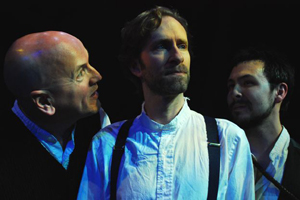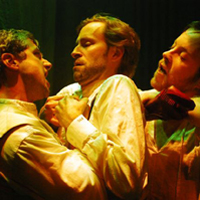From the Chicago Sun-Times
Lifeline’s silver starts with gold
‘Dr. Moreau’ is a fitting opener for cutting-edge company’s 25th
October 24, 2007
By Hedy Weiss
Highly Recommended
It was not just science fiction that H.G. Wells was writing when he penned his novel The Island of Dr. Moreau. Rather, Wells’ 1896 book delivered a blistering attack on colonialism, a fascinating meditation on Darwin’s still new theories, and a prophetic look at eugenics (the science of “improving” on hereditary traits). In addition, the book was a fiery indictment of Victorian English values, and the uses to which religion, democracy, the law and punishment could be put. Deeply questioning of what constitutes civilization, Wells also mused on the question of what separates men from beasts.
All these themes, plus enough ghoulish theatricality for a lifetime of Halloweens, are in play in the hugely ambitious, wildly physical, stunningly effective 90-minute stage version of Wells’ story that opened Monday at Lifeline Theatre — the initial production in this most engaging company’s 25th season. But look more closely at the production — adapted with wit and intelligence by Robert Kauzlaric and ingeniously directed by Paul S. Holmquist — and you quickly sense the intensely contemporary political subtext at work here, too. Britain was the superpower of the late 19th century, but the United States holds that title now, and our role on the global stage, particularly in “developing societies,” is grist for this show’s mill, as are images from Abu Ghraib, the Iraqi prison.
The story that unspools in flashback in “Dr. Moreau” is not all that different from the one told by Joseph Conrad in Heart of Darkness, published just a few years later. Edward Prendick (an ideally soul-broken Phil Timberlake) is a mild-mannered scientist who, on his voyage home to London after an expedition to Peru to study butterflies, becomes the lone survivor of a shipwreck. Rescued by another Englishman and former medical student, Montgomery (a perfectly debauched Yosh Hayashi), he is taken to a remote Pacific island where Moreau (a wonderfully cold-blooded Nigel Patterson), already notorious for his bizarre experiments at home, freely runs his demonic lab.
The goal at Moreau’s hellish, pain-inflicting lab? Perfect the animal kingdom by turning wild creatures into humanlike specimens. (Clearly this is a metaphor for colonialists’ claims they were improving the lot of the “backward peoples” they conquered and brutally subjugated.)
Moreau’s man-beasts, who have lost all sense of identity, arrive onstage in a marvelous hybrid of fur and human attire, the creations of masterful costume and mask designer Kimberly G. Morris. A large ensemble, including Sean Sullivan (marvelous as the gentle giant, M’Ling, half-bear, half-ox), Tony Bozzuto, Tiffany Joy Ross, Aaron Snook, Paul Myers, Stacie Barra, Dan Hale, Sienna Harris and Jonathan Stutzman all help put “The Planet of the Apes” to shame.
Tom Burch’s fantastical ship-and-shore set, Kevin D. Gawley’s stormy lights and Victoria DeIorio’s rousing music richly enhance this harrowing voyage.
From the Daily Herald
‘Moreau’ production completely engrossing
October 25, 2007
By Barbara Vitello
Lifeline Theatre may not deliver spectacle on the scale of that found in Chicago’s theater district, but the talented ensemble never fails to impress. And in many ways, smaller scale notwithstanding, its artistry rivals that of its better financed downtown counterparts. Case in point: its chilling production of H.G. Wells’ “The Island of Dr. Moreau.”
Working out of a small Rogers Park theater, on a modest budget, Lifeline delivers a bold, adrenaline-fueled adaptation of Wells’ tale of shipwrecked lepidopterologist Edward Prendick (a pallid Phil Timberlake, compelling as a reasonable man driven beyond reason) transformed by his encounter with evil masquerading as enlightenment.
Having survived days adrift at sea and a rescue ship crewed by brutish sailors led by a merciless captain (Tony Bozzuto), Prendick finds himself on a remote island inhabited by Montgomery (fine work by Yosh Hayashi as the sardonic, self-loathing former physician) assistant to the disgraced Dr. Moreau (a disturbingly dispassionate Nigel Patterson). After news of his vivisection experiments forced him into exile, Moreau retreated to an island. Resuming his experiments to accelerate evolution and create a new species, he has populated his anti-utopia with a grotesque menagerie of human-beast hybrids, who he presides over like a god, demanding obedience to laws contrary to the fundamental nature of the beasts.
Sean Sullivan’s affecting turn as the loyal hybrid M’Ling, and Paul Myers’ manic Jabbering One deserve mention, along with the rest of the ensemble consisting of Dan Hale, Sienna Harris, Lynette Morris (substituting for Stacie Barra at Saturday’s press performance), Tiffany Joy Ross, Aaron Snook and Jonathan Stutzman.
Astutely directed by Paul S. Holmquist and adapted by Robert Kauzlaric — who condenses the disturbing 1896 novel into a tense 90 minutes — Lifeline’s production is a superior bit of seasonally appropriate theater that manages to both chill the spine and stimulate the mind.
The philosophical debates between Prendick and Moreau border on the pedantic, but Kauzlaric’s streamlined narrative is sound. As for the production’s look, let’s just say Lifeline accomplishes remarkable things within its confined space. Tom Burch’s arresting set morphs seamlessly from 19th-century schooner to a profane Eden made more menacing by Kevin D. Gawley’s murky lighting and Victoria Delorio’s unsettling sound effects and primal music, whose wailing violins and frenzied flutes recall the island’s unfortunate inhabitants. Add to that Kimberly G. Morris’ fantastical masks and costumes, and you have a show that grabs you and refuses to let go.
A gripping combination of tension and bombast, “Moreau” makes for engrossing theater and a shrewd cautionary tale about what happens when science outpaces morality; progress takes priority over principles; and outsiders impose order at the point of gun upon a community they don’t understand. In that respect, “The Island of Dr. Moreau” remains as scathing a social critique today as it did a century ago.
From the Windy City Times
The Island of Dr. Moreau
October 31, 2007
By Catey Sullivan
The fuzzy and fanged beasties that claw and growl their way through the Island of Dr. Moreau in Lifeline Theatre’s adaptation of H.G. Wells alarming classic are among the season’s more amazing feats of stagecraft. Designed by Kimberly G. Morris, they’re supreme examples of innovation, intelligence and theatricality. And they may be too good for the bloody drama’s own good: These creatures are so realistic that when the good doctor starts slicing them open sans anesthesia, The Island of Dr. Moreau becomes a distressing place to be indeed.
Vivisection as a medical concept is one thing. Viewed under an unflinching glare as it’s practiced on a splayed and wailing puma, it’s emotionally dismaying even if one knows intellectually that the puma is really an actor who most likely remains unharmed in director Paul S. Holmquist’s appropriately shocking interpretation of a shocking tale.
The Island of Dr. Moreau is a sprawling sci-fi horror story, launched with a violent storm, a ship dashed to splinters and a butterfly collector cast adrift somewhere between Peru and the rest of the world. It travels to the perilous cliffs and foreboding caves of the title island and across the seas to the London of Jack the Ripper and the Elephant Man. In all, it’s a multi-tentacled morass of a story: Adaptor Robert Kauzlaric deserves mighty credit for honing it to a vivid 90 minutes without compromising the narrative. Yet its very bloodthirstiness – without which Wells’ story would be gutted – makes Moreau difficult to take.
At its grisly heart is Dr. Moreau ( Nigel Patterson, ruthless, monomaniacal and as fiendishly attractive as Sweeney Todd’s long-lost brother ) , a fellow with plays God, cracking “the bullwhip of evolution” by slicing open animals and reconfiguring them as quasi-human. ( The key difference between the two: “An animal may be cunning and ferocious, but it takes a real man to tell a lie.” ) In one astounding scene, Moreau embarks on a bit of self-surgery, slowly driving what appears a foot-long syringe into his arm. It so looks ferociously real, skin slowly bulging over the burrowing needle, that one hopes Patterson had a tetanus shot as part of his compensation package.
In less flashy but no less valuable roles are Phil Timberlake as the gaunt, ghost-eyed butterfly collector who eventually leaves the island but will never truly escape it and Yosh Hayashi as a dissolute, wry and ancient-before-his-time soul whose only relief comes from quoting Shakespeare and blackout drinking.
Moreau is taut, exciting and unforgettable. But if you’re the sort who goes soft at the thought of animal experimentation or homeless pets, you might want to take your ticket money and make a donation to PETA instead.
From Chicago Free Press
The Island of Dr. Moreau
October 31, 2007
By Lawrence Bommer
Amid all the horrors unleashed in this Halloween-ready tale of terror, there’s a stunning discovery–how relevant H.G. Wells’ melodramatic, Victorian-era cautionary tale is to 2007. Wells knew nothing of bio-engineering, or gene splicing of recombinant DNA, but this scary story of a mad scientist on a tropical island who considers himself the ultimate agent of evolution is warning enough for three centuries. Retold with a passion that never congeals into camp, Robert Kauzlaric’s adaptation, powerfully portrayed in Paul S. Holmquist’s Lifeline Theatre world premiere, offers 90 minutes of thoughtful fright.
Our soul-shocked narrator is a butterfly collector named Edward Prendick (Phil Timerlake in a state of understandable hysteria). He attempts to explain how “terror is a disease” (one, we know, that an entire nation can catch to the detriment of their civil liberties). Prendick’s immersion in sheer fear occurs when he’s shipwrecked, rescued and transported to a “biological station” run by Dr. Moreau, a London physician exiled because of his cruel experiments on laboratory animals. Reviling scientists as “useless God killers,” the sailors abandon Prendick to his fate on an isle visited only once a year by a supply ship.
With an entire realm of innocent fauna at his cruel disposal (giving a new meaning to “Animal Farm”), whip-cracking Moreau (Nigel Patterson, revelling in declamatory British acting) busily employs surgical grafts too horrible to contemplate as he transforms beasts to men (rather than, as Prendrick naturally surmises, men to beasts). Shaping their larynxes so they can speak, this early eugenicist teaches them The Law (Never go on four legs, eat flesh or scrape bark from trees). In Moreau’s “House of Pain” he plays God, advancing an “evil-ution” that becomes an anthropomorphic nightmare of escalating violence. He’s aided by his Shakespeare-spouting assistant, Montgomery (Yosh Hayashi, an eager Igor to Moreau’s Frankenstein). Together they intend to upgrade animals into humans, a questionable improvement at best. But instinct will out: Moreau must contend with a reversion to type that ends his experiment in an eruption of bestial revenge. (I love how the animals’ chant of “We Are Men” turns into a much more menacing “We Are Many.”)
What’s curiously endearing about this neo-Faustian tale of human presumption in co-opting and corrupting natural selection is not the portrait of social Darwinism gone apeshit. It’s the power of these human hybrids, oddly moving in Kimberly G. Morris’ marvelous masks and costumes, to touch us. Morphed into semi-humans, these botched apes, sheep, pumas, and bears are marvelous creations, whether as theater and literature, reason enough to see this enormously entertaining blast from the past.



























